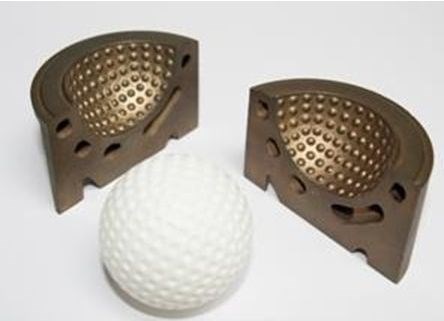This Golf Ball Mold is Really Cool
Producing this golf ball mold (left) involved both additive and subtractive manufacturing processes working together in an integrated fashion.
Share










Producing this golf ball mold (left) involved both additive and subtractive manufacturing processes working together in an integrated fashion. At right is the copper EDM electrode used to detail the cavity. The small segment nearby shows the internal cooling channels.
One of the "coolest" exhibits I saw at IMTS was this steel mold for a plastic, blow-molded golf ball. It's cool for two reasons.
- It demonstrated how direct metal laser centering (DMLS) could create "conformal cooling channels" that would be impossible to machine from a solid.
- It demonstrated how DMLS was combined with high speed milling, wire and die sinking EDM (electrical discharge machining) in an integrated, nearly automatic process chain. The details of this process chain were shown by AgieCharmilles, a supplier of high speed milling and EDM equipment, and EOS, a supplier of laser sintering systems.
The cooling channels are called "conformal" because they conform closely to the shape of the mold cavity. In this case, the channels spiral around the cup-shaped mold cavity just underneath its outer surface. This enables them to cool the mold and solidify the injected plastic rapidly and evenly for a significant productivity gain in operation. That is, the mold can produce more finished golf balls in less time and with less energy than conventionally designed and machine molds.
The internal spiraling channels would be impossible to machine from solid. Such complex internal shapes, however, are quite practical to produce when the workpiece is built up by a progressively fusing powdered metal, layer by layer, with a high-powered laser, which is the essence of the DMLS process.
Here is how the integrated manufacturing process chain works as described by the press release from EOS and AgieCharmilles. “An EOSINT M 270 DMLS system creates a steel mold for a plastic, blow-molded golf ball, complete with conformal cooling channels and the fixturing needed for all successive stages of machining. This mold will then move through a secondary process chain that includes a GF AgieCharmilles HSM 400U LP high-speed milling machine, an FO 350MS die sinking EDM and a Cut20P wire EDM. The wire EDM cuts off the fixturing, and the HSM 400ULP will cut the parting lines for a flash-free (no leakage) surface and leave the mold ready for production use.
“A significant advantage of DMLS is that it produces a near-net part, in one operation, that is ready for secondary finishing. Single fixturing is then used for all secondary operations to reduce manual benchworking and generate surface finishes accurate to within three to five microns. The process minimizes scrap by eliminating many of the progressive operations involved in subtractive toolmaking processes that start with a block of raw material.
“This breakthrough manufacturing process chain is one that runs virtually unbroken from design to finished product. Machines used in the process are networked together and operate from the same 3D CAD model data from start-to-finish to increase accuracy and reduce set-up times.”
Related Content
-
Designing a 3D Printed Part with Machining in Mind
Designing extra stock and mounting features into a 3D printed part can aid in machining processes downstream.
-
The Cool Parts Showcase Seeks Innovative 3D Printed Parts
Do you solve problems with 3D printing? Enter your 3D printed parts in this contest from The Cool Parts Show.
-
In Moldmaking, Mantle Process Addresses Lead Time and Talent Pool
A new process delivered through what looks like a standard machining center promises to streamline machining of injection mold cores and cavities and even answer the declining availability of toolmakers.






































